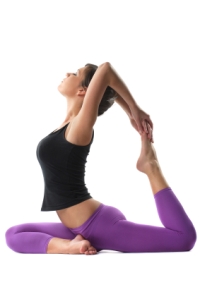As we come to a close with the series, “What Your Favorite Yoga Pose Says About You,” I’ll ring in Trikonasana or Triangle Pose. In Sanskrit, tri means three and kona means corner, which is the  shape of the body (primarily the legs) when expressing this fundamental yoga pose.
shape of the body (primarily the legs) when expressing this fundamental yoga pose.
Another one of my favorite poses (notice the theme of the selection process here), Trikonasana strengthens the core, particularly the obliques. Control your descent and ascent into the pose with your core to protect your back and hips. We often strengthen our rectus abdominus muscles (upper), but neglect our transverse abdominals (lower), and obliques. And when our core muscles atrophy, our back weakens. When done correctly, triangle stretches the muscles of the groin, ankles, hamstrings, calves, hips, spine and chest. Tight hips often manifest in back pain, so this opening pose can actually relieve back pain.
From Tadasana (mountain pose), step your left foot back three and a half feet or more, and ground your left foot so it’s parallel with the back edge of your mat. A good way to determine if your stance is wide enough is to spread your arms and see if your ankles are below your wrists. From this standing pose, shift your hips back toward the back of your mat and extend your right arm far out over your right ankle before lowering your right hand to the floor to ensure length in the side body and spine. Be careful not to lock your knees and ground your right big toe into the mat so you aren’t rolling to the outside of your foot. This subtle adjustment facilitates strengthening the arch of your foot.
Let go of ego when sinking into Triangle. If you can’t bring your hands all the way to the floor without collapsing into your side, bring your hands up to your shin or a block. Open your hips, open your chest, extend your left arm and gaze to the ceiling and protect your neck by keeping your head parallel to the floor and maintain length in both sides of the neck. Continue reading


